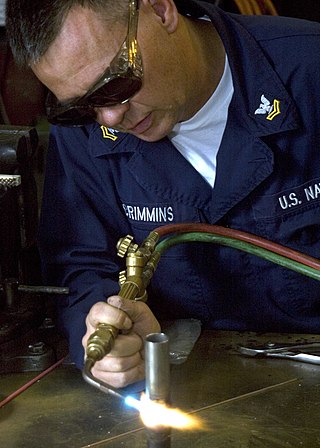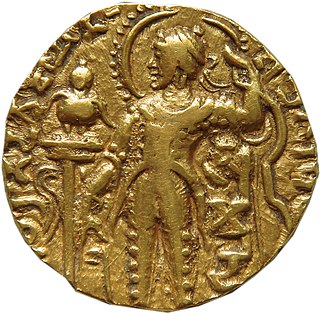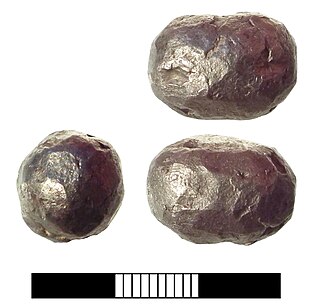Related Research Articles

An alloy is a mixture of chemical elements of which in most cases at least one is a metallic element, although it is also sometimes used for mixtures of elements; herein only metallic alloys are described. Most alloys are metallic and show good electrical conductivity, ductility, opacity, and luster, and may have properties that differ from those of the pure elements such as increased strength or hardness. In some cases, an alloy may reduce the overall cost of the material while preserving important properties. In other cases, the mixture imparts synergistic properties such as corrosion resistance or mechanical strength.

A metal is a material that, when polished or fractured, shows a lustrous appearance, and conducts electricity and heat relatively well. These properties are all associated with having electrons available at the Fermi level, as against nonmetallic materials which do not. Metals are typically ductile and malleable.

Metallurgy is a domain of materials science and engineering that studies the physical and chemical behavior of metallic elements, their inter-metallic compounds, and their mixtures, which are known as alloys.

The general term slag may be a by-product or co-product of smelting (pyrometallurgical) ores and recycled metals depending on the type of material being produced. Slag is mainly a mixture of metal oxides and silicon dioxide. Broadly, it can be classified as ferrous, ferroalloy or non-ferrous/base metals. Within these general categories, slags can be further categorized by their precursor and processing conditions. Slag generated from the EAF process can contain toxic metals, which can be hazardous to human and environmental health.

Metalworking is the process of shaping and reshaping metals in order to create useful objects, parts, assemblies, and large scale structures. As a term, it covers a wide and diverse range of processes, skills, and tools for producing objects on every scale: from huge ships, buildings, and bridges, down to precise engine parts and delicate jewelry.

Brazing is a metal-joining process in which two or more metal items are joined by melting and flowing a filler metal into the joint, with the filler metal having a lower melting point than the adjoining metal.

An ingot is a piece of relatively pure material, usually metal, that is cast into a shape suitable for further processing. In steelmaking, it is the first step among semi-finished casting products. Ingots usually require a second procedure of shaping, such as cold/hot working, cutting, or milling to produce a useful final product. Non-metallic and semiconductor materials prepared in bulk form may also be referred to as ingots, particularly when cast by mold based methods. Precious metal ingots can be used as currency, or as a currency reserve, as with gold bars.

Scrap consists of recyclable materials, usually metals, left over from product manufacturing and consumption, such as parts of vehicles, building supplies, and surplus materials. Unlike waste, scrap can have monetary value, especially recovered metals, and non-metallic materials are also recovered for recycling. Once collected, the materials are sorted into types – typically metal scrap will be crushed, shredded, and sorted using mechanical processes.
Plating is a finishing process in which a metal is deposited on a surface. Plating has been done for hundreds of years; it is also critical for modern technology. Plating is used to decorate objects, for corrosion inhibition, to improve solderability, to harden, to improve wearability, to reduce friction, to improve paint adhesion, to alter conductivity, to improve IR reflectivity, for radiation shielding, and for other purposes. Jewelry typically uses plating to give a silver or gold finish.

Electrowinning, also called electroextraction, is the electrodeposition of metals from their ores that have been put in solution via a process commonly referred to as leaching. Electrorefining uses a similar process to remove impurities from a metal. Both processes use electroplating on a large scale and are important techniques for the economical and straightforward purification of non-ferrous metals. The resulting metals are said to be electrowon.

The history of metallurgy in the Indian subcontinent began prior to the 3rd millennium BCE. Metals and related concepts were mentioned in various early Vedic age texts. The Rigveda already uses the Sanskrit term ayas. The Indian cultural and commercial contacts with the Near East and the Greco-Roman world enabled an exchange of metallurgic sciences. The advent of the Mughals further improved the established tradition of metallurgy and metal working in India. During the period of British rule in India, the metalworking industry in India stagnated due to various colonial policies, though efforts by industrialists led to the industry's revival during the 19th century.

A foundry is a factory that produces metal castings. Metals are cast into shapes by melting them into a liquid, pouring the metal into a mold, and removing the mold material after the metal has solidified as it cools. The most common metals processed are aluminum and cast iron. However, other metals, such as bronze, brass, steel, magnesium, and zinc, are also used to produce castings in foundries. In this process, parts of desired shapes and sizes can be formed.
Archaeometallurgy is the study of the past use and production of metals by humans. It is a sub-discipline of archaeology and archaeological science.
Semi-solid metal casting (SSM) is a near net shape variant of die casting. The process is used today with non-ferrous metals, such as aluminium, copper, and magnesium. It can work with higher temperature alloys that lack suitable die materials. The process combines the advantages of casting and forging.The process is named after the fluid property thixotropy, which is the phenomenon that allows this process to work. Thixotropic fluids flow when sheared, but thicken when standing. The potential for this type of process was first recognized in the early 1970s. Its three variants are thixocasting, rheocasting, and thixomolding. SIMA refers to a specialized process to prepare aluminum alloys for thixocasting using hot and cold working.

The mineral industry is one of the main sectors of the Armenian economy and in 2017 accounted for 30.1% of its exports.

Metals and metal working had been known to the people of modern Italy since the Bronze Age. By 53 BC, Rome had expanded to control an immense expanse of the Mediterranean. This included Italy and its islands, Spain, Macedonia, Africa, Asia Minor, Syria and Greece; by the end of the Emperor Trajan's reign, the Roman Empire had grown further to encompass parts of Britain, Egypt, all of modern Germany west of the Rhine, Dacia, Noricum, Judea, Armenia, Illyria, and Thrace. As the empire grew, so did its need for metals.
Carlton Forge Works is an aerospace manufacturing company that produces seamless rolled rings. Carlton was founded in 1929 and was privately held. According to Manta and Business Week, the company has about 250-300 employees. The company was previously owned by Allan Carlton.
Metal-Expo is an international exhibition for steel producers, users, as well as manufacturers and suppliers of steel processing equipment. It has been held yearly since 1995 in Moscow at the All-Russia Exhibition Centre.

Dowa Holdings is a Japanese nonferrous metals manufacturer. The company is a component of the Nikkei 225 stock index.

Non-ferrous extractive metallurgy is one of the two branches of extractive metallurgy which pertains to the processes of reducing valuable, non-iron metals from ores or raw material. Metals like zinc, copper, lead, aluminium as well as rare and noble metals are of particular interest in this field, while the more common metal, iron, is considered a major impurity. Like ferrous extraction, non-ferrous extraction primarily focuses on the economic optimization of extraction processes in separating qualitatively and quantitatively marketable metals from its impurities (gangue).
References
- ↑ Fahlman, Bradley D. (18 March 2011). Materials chemistry (2nd ed.). Dordrecht [u.a.]: Springer. ISBN 978-94-007-0692-7.
- ↑ "Non-Ferrous Metals". Engineers Handbook. Archived from the original on 4 June 2016. Retrieved 25 October 2011.
- ↑ Gupta, R. C. (2010). Theory and laboratory experiments in ferrous metallurgy. New Delhi: PHI Learning Private Ltd. p. 6. ISBN 978-81-203-3924-8.
- ↑ "Commonly Recycled Metals and Their Sources" (PDF). lOccupational Safety and Health Administration . Retrieved 27 October 2011.
- ↑ Young, Courtney A., ed. (2008). Hydrometallurgy 2008 : proceedings of the sixth international symposium (1st ed.). Littleton, Colo.: Society for Mining, Metallurgy, and Exploration. p. 416. ISBN 978-0-87335-266-6.
- ↑ "Chapter 82 – Metal Processing and Metal Working Industry". Encyclopaedia of Occupational Health and Safety, 4th Edition. Retrieved 26 October 2011.
- ↑ "Non-Ferrous Metals". Bureau of International Recycling. Archived from the original on 21 October 2016. Retrieved 26 October 2011.
- ↑ "Department of the Environment Industry Profile: Waste recycling, treatment and disposal sites" (PDF). Environment Agency. Archived from the original (PDF) on 25 April 2012. Retrieved 27 October 2011.
- ↑ Robert Noyes (1993). Pollution Prevention Technology Handbook. Noyes Publications. ISBN 978-0815513117.
- 1 2 McNeil, Ian, ed. (1990). Encyclopedia of the History of Technology. London: Routledge. pp. 47–66. ISBN 978-0-203-19211-5.
- ↑ Forbes, R. J. (1971). Studies in Ancient Technology, Volume 3; Volume 1965. BRILL. p. 16. ISBN 978-90-04-02652-0.
- ↑ "Non-ferrous Metal Applications". All Metals & Forge Group. 16 April 2013. Archived from the original on 24 September 2015. Retrieved 1 October 2013.